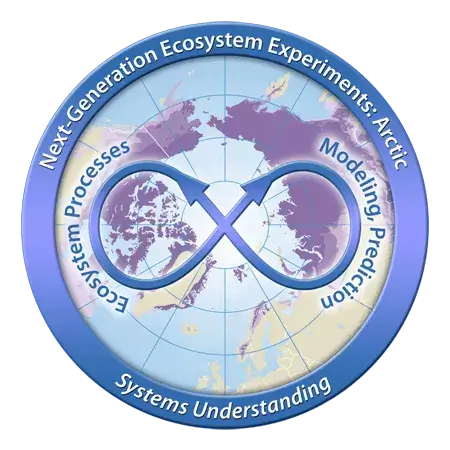Wu, Yuxin, et al. “Electrical and Seismic Response of Saline Permafrost Soil During Freeze - Thaw Transition”. Journal of Applied Geophysics, vol. 146, 2017, pp. 16-26, https://doi.org/10.1016/j.jappgeo.2017.08.008.
Publications
Displaying 201 - 220 of 334
By year of publication, then alphabetical by title
- Raz-Yaseef, Naama, et al. “Evapotranspiration across Plant Types and Geomorphological Units in Polygonal Arctic Tundra”. Journal of Hydrology, vol. 553, 2017, pp. 816-25, https://doi.org/10.1016/j.jhydrol.2017.08.036.
- Xu, Xiaofeng, et al. “Global Pattern and Controls of Soil Microbial Metabolic Quotient”. Ecological Monographs, vol. 87, no. 3, 2017, pp. 429-41, https://doi.org/10.1002/ecm.1258.
- Herndon, Elizabeth M., et al. “Influence of Iron Redox Cycling on Organo-Mineral Associations in Arctic Tundra Soil”. Geochimica Et Cosmochimica Acta, vol. 207, 2017, pp. 210-31, https://doi.org/10.1016/j.gca.2017.02.034.
- Raz-Yaseef, Naama, et al. “Large Carbon Dioxide and Methane Emissions from Polygonal Tundra During Spring Thaw in Northern Alaska”. Geophysical Research Letters, vol. 44, no. 1, 2017, pp. 504-13, https://doi.org/10.1002/2016GL071220.
- Shelef, Eitan, et al. “Large Uncertainty in Permafrost Carbon Stocks Due to Hillslope Soil Deposits”. Geophysical Research Letters, vol. 44, no. 12, 2017, pp. 6134-4, https://doi.org/10.1002/grl.v44.1210.1002/2017GL073823.
- Wainwright, Haruko M., et al. “Mapping Snow Depth Within a Tundra Ecosystem Using Multiscale Observations and Bayesian Methods”. The Cryosphere, vol. 11, no. 2, 2017, pp. 857-75, https://doi.org/10.5194/tc-11-857-2017.
- Grant, Robert F., et al. “Mathematical Modeling of Arctic Polygonal Tundra With Ecosys: 1. Microtopography Determines How Active Layer Depths Respond to Changes in Temperature and Precipitation”. Journal of Geophysical Research: Biogeosciences, vol. 122, no. 12, 2017, pp. 3161-73, https://doi.org/10.1002/2017JG004035.
- Grant, Robert F., et al. “Mathematical Modeling of Arctic Polygonal Tundra With Ecosys: 2. Microtopography Determines How Carbon Dioxide and Methane Exchange Responds to Changes in Temperature and Precipitation”. Journal of Geophysical Research: Biogeosciences, vol. 122, no. 12, 2017, pp. 3174-87, https://doi.org/10.1002/2017JG004037.
- Yang, Ziming, et al. “Microbial Community and Functional Gene Changes in Arctic Tundra Soils in a Microcosm Warming Experiment”. Frontiers in Microbiology, vol. 27, no. 3, 2017, https://doi.org/10.3389/fmicb.2017.01741.
- Dwivedi, Dipankar, et al. “Mineral Properties, Microbes, Transport, and Plant-Input Profiles Control Vertical Distribution and Age of Soil Carbon Stocks”. Soil Biology and Biochemistry, vol. 107, 2017, pp. 244-59, https://doi.org/10.1016/j.soilbio.2016.12.019.
- Maggi, Federico, and William J. Riley. “Near Activation and Differential Activation in Enzymatic Reactions”. International Journal of Chemical Kinetics, vol. 49, no. 5, 2017, pp. 305-18, https://doi.org/10.1002/kin.21076.
- Mauritz, Marguerite, et al. “Nonlinear Carbon Dioxide Flux Response to 7 years of Experimentally Induced Permafrost Thaw”. Global Change Biology, no. 23, 2017, pp. 3646–3666, https://doi.org/10.1111/gcb.13661.
- Muster, Sina, et al. “PeRL: A circum-Arctic Permafrost Region Pond and lake database”. Earth System Science Data, vol. 9, no. 1, 2017, pp. 317-48, https://doi.org/10.5194/essd-9-317-2017.
- Wullschleger, Stan D. “Profile: Stan D. Wullschleger”. New Phytologist, vol. 216210160, no. 4, 2017, pp. 981-3, https://doi.org/10.1111/nph.14869.
- Léger, Emmanuel, et al. “Quantification of Arctic Soil and Permafrost Properties Using Ground-Penetrating Radar and Electrical Resistivity Tomography Datasets”. IEEE Journal of Selected Topics in Applied Earth Observations and Remote Sensing, vol. 10, no. 10, 2017, pp. 4348-59, https://doi.org/10.1109/JSTARS.2017.2694447.
- Andresen, Christian G., et al. “Rising Plant-Mediated Methane Emissions from Arctic Wetlands”. Global Change Biology, no. 3, 2017, pp. 1128-39, https://doi.org/10.1111/gcb.13469 .
- Svyatskiy, Daniil, and Konstantin Lipnikov. “Second-Order Accurate Finite Volume Schemes With the Discrete Maximum Principle for Solving Richards’ Equation on Unstructured Meshes”. Advances in Water Resources, vol. 104, 2017, pp. 114-26, https://doi.org/10.1016/j.advwatres.2017.03.015.
- Tang, Jinyun Y., and William J. Riley. “SUPECA Kinetics for Scaling Redox Reactions in Networks of Mixed Substrates and Consumers and an Example Application to Aerobic Soil Respiration”. Geoscientific Model Development, vol. 10, no. 9, 2017, pp. 3277-95, https://doi.org/10.5194/gmd-10-3277-201710.5194/gmd-10-3277-2017-supplement.
- Rogers, Alistair, et al. “Terrestrial Biosphere Models Underestimate Photosynthetic Capacity and Carbon Dioxide Assimilation in the Arctic”. New Phytologist, vol. 216: 1090-1103, no. 4, 2017, pp. 1090-03, https://doi.org/10.1111/nph.14740.

